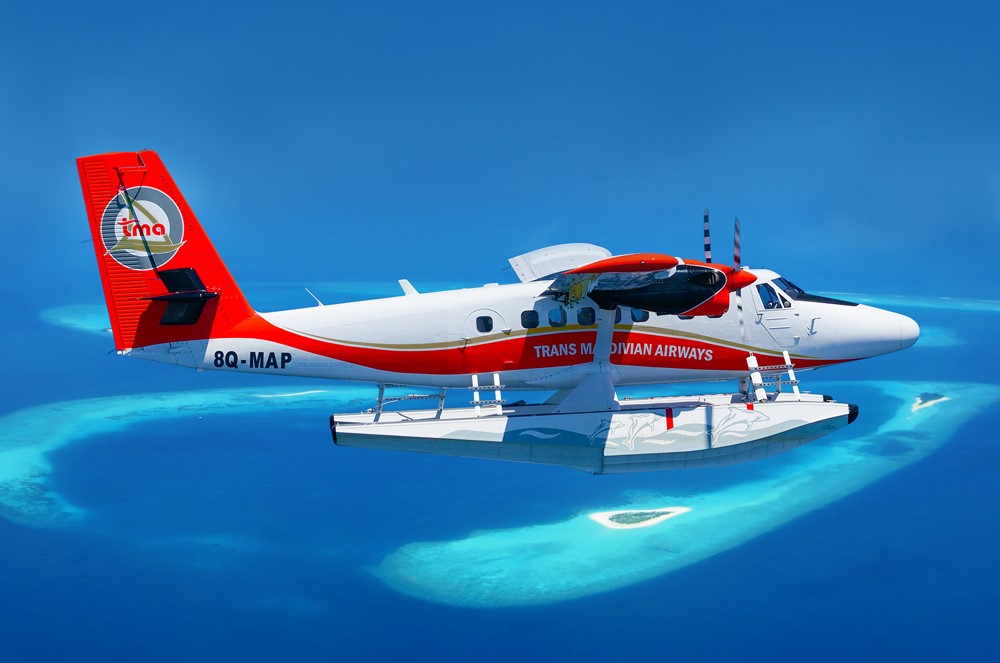How reliable are the Twin Otter seaplanes that operate across the Maldives which is made up of over 1190 tiny islets spread over an area equivalent to France?
This tiny county is one of the world’s luxurious tourism destinations that attracts about two million holidaymakers each year.
Among the four international airports in the country, there is only one that serves over 95% of the international arrivals and the rest usually caters for private jets and occasional charters. Resorts that are close to the main Velana International Airport usually offer speedboat transfer between the airport and the resort. For the rest of the islands, it is either domestic flight or seaplane, the latter is more common and popular among the tourists.
The Twin Otter originally came with a conventional undercarriage but was then fitted with pontoons to land and take off on water. Produced by De Havilland Canada, this is the most popular seaplane in the Maldives. In fact, this is the only model of seaplane used by 3 different companies in the country.
The first tourist resort in the Maldives was opened in 1972 at Vihamnaafushi island as Kurumba Village, today the resort is known as Kurumba Maldives.
To cater for the needs of growing tourism Hummingbird Island Helicopters was founded in 1989 with few helicopters, due to a lack of infrastructure and reliability issues most of the resorts still relied on traditional wooden boats that took several hours for the transfer. In 1991 Lars Erik Nielsen travelled to Kuredu Island Resort which took 7 hours for the journey and many tourists fell seasick. That was when Mr Nielsen felt the need for better transportation.

In 1993 the Maldivian Air Taxi was born with just two Twin Otter aircraft. Since it can land and take off at sea there was no need to develop infrastructure in resorts. Quickly the Twin Otter proved itself with high reliability and safety in different weather conditions. That led to tremendous growth of the seaplane market in the Maldives. Today, Trans Maldivian is the world’s largest seaplane operator, the company that began service in 1993 with few rented aircraft today operates 62 aircraft in its fleet and flies to 79 destinations.
Other competitors in the market include Island Aviation Services operating as Maldivian, and Manta Air. All the seaplane operators chose the reliability-tested Twin Otter.
For safety reasons, seaplanes in Maldives fly only in the daytime. Their operations start early morning at sunrise and end at sunset. Even though there are no fixed runways there are sea-based runways at different resorts. The resort operators and seaplane companies exchange information during the construction of villas, especially water villas, to leave enough space in the lagoon for seaplanes to land and take off during different seasons.
On some islands, it is the same sea runway that is used in all seasons. Resorts usually operate speedboats and wooden boats called Dhoni for various activities such as water sports or diving. The movement of boats is channelled away from the runway for seaplanes.
During the day there is good visibility for pilots to monitor conditions in the whole area. When seaplanes get chartered to unusual destinations the aircraft usually performs a few circles above the landing spot to ensure clearance.
Having two engines is double the safety and while a rare experience to have engine issues in the Twin Otter there have been the occasional case. A blogger writing to Maldives Resorts shared one such case in which the seaplane landed perfectly but had an engine issue at a resort in Meemu Atoll. An engine change was required and another aircraft delivered a spare engine, a portable crane and tools. Engineers had the engine changed within a few hours.
Trans Maldivian keeps spare engines available that save time and loss of revenue.
The regular Twin Otter can accommodate up to 16 passengers. Based on baggage weight there may be some empty seats in the aircraft. These seaplanes are not airconditioned but there are small fans behind the cockpit for cooling. Some of the aircraft have air inlets in windows and that helps passengers stay cool.
The VIP aircraft come with fewer seats that are bigger and more luxurious, and this aircraft has air conditioning as well. Most of the private charters for couples or small families usually take place with this aircraft. But, in peak periods the availability becomes tight and many guests have no choice except the regular seaplane.

All the seaplane operators in the Maldives have VIP aircraft. Resorts choose one company for an exclusive contract under which the seaplane operator commits to operate flights based on the demand, at fixed pricing. So, even if there is just one guest the seaplane operator must provide a transfer and the price cannot be increased. On the other hand, the resorts are restricted from doing business with other seaplane companies. In very rare cases if the TMA cannot provide VIP aircraft it may hire from other airlines and cater to the resort. Capacity issues usually affect only the VIP transfers. For regular operations the airlines estimate demand and keep enough aircraft, they only do contact based on available capacity.
























